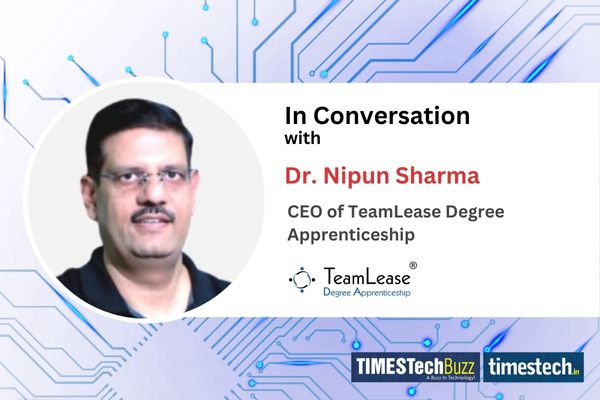In an interview with TimesTech, Dr. Nipun Sharma, CEO of TeamLease Degree Apprenticeship, highlighted the urgent need to scale India’s skilling and apprenticeship ecosystem. Emphasizing a target of 20 million apprentices by 2030, he stressed that apprenticeships can bridge the workforce gap for a $7T economy, particularly in emerging sectors like AI, green energy, and gig work.
Read the full interview here:
TimesTech: Is India’s current skilling and apprenticeship ecosystem equipped to create 8 million jobs a year and meet the 2047 vision?
Nipun: India’s Chief Economic Advisor V Anantha Nageswaran has put it very succinctly – India needs to create roughly 8 million jobs every year through the next decade to achieve a developed‐country status by 2047. However, we face a significant skills shortfall. NSDC estimates demand for 103 million skilled workers by 2025 against just 74 million currently trained, implying a gap of ~30 million. Apprenticeships are growing – from ~35,000 in 2018 to nearly 1.4 million in 2024 but still cover only 0.2% of India’s workforce (versus ~3–4% in leading economies). In short, today’s skilling ecosystem is not yet sufficient to produce 8 million trained workers annually. To meet Vision 2047, India must scale skilling dramatically (e.g. targeting ~20 million apprentices by 2030 for a $7T economy) and close skill gaps and talent shortage in emerging and critical sectors like AI, green tech, etc.
TimesTech: How can industries and MSMEs be motivated to adopt and scale apprenticeship programs more actively?
Nipun: Industry adoption hinges on clear value propositions and support. Apprenticeships reduce talent acquisition cost by 50% compared to talent hired externally and attrition (10–25%) while boosting productivity (20–25%). MSMEs can leverage these efficiency gains: on-the-job apprentices contribute real work (raising ROI) and enlarge the talent pipeline To drive scale, policymakers and industry bodies can highlight success stories, simplify registration, and offer tax/CSR credits for apprenticeship hires. Public–private campaigns should emphasize that apprenticeships are a win-win – formalizing skills in the workforce and cutting training costs for employers
TimesTech: With automation and AI reshaping work, how is TeamLease preparing apprentices for future-ready roles like green economy and gig work?
Nipun: India’s green jobs could nearly double by 2047 (from ~18.5 M to 35 M jobs). Apprenticeship programs are tailored accordingly – training solar/PV technicians, EV and battery engineers, waste-management specialists, etc. – so youth gain the specialized skills those sectors need. For the gig and digital economy, our studies have shown that employers stress digital fluency and AI literacy: 90% of employers say gig workers must master digital tools. Accordingly, TeamLease is embedding tech-enabled learning (e.g. VR/AI simulations, generative-AI tools) into apprenticeships. In practice, this means courses in AI/IoT, cloud and coding, plus project work on gig-platform tasks. By integrating sustainability and automation skills, TeamLease is equipping apprentices for roles in clean energy, smart manufacturing, AI-driven services and other “future jobs.”
TimesTech: Can degree apprenticeships evolve to support broader employment models like entrepreneurship and freelancing?
Nipun: Yes, degree apprenticeships have strong potential to support broader employment models such as entrepreneurship and freelancing. These programs can be designed to help students acquire real-world skills while continuing their academic journey—skills that are especially valued by startups, which often prioritize capability and adaptability over pedigree. Moreover, startups typically offer a shorter bench-to-work time, allowing apprentices to contribute meaningfully from day one. By integrating modules on entrepreneurship, project-based learning credits, and flexible work components, degree apprenticeships can formally recognize and develop self-employment skills. For instance, students could take on freelance assignments or work on startup projects as part of their curriculum, guided by mentors. Their output—whether a working prototype, a digital marketing campaign, or a client solution—can be credited toward their degree.
TimesTech: What role will public-private partnerships and real-time labor market data play in building a job-ready workforce, and how is TeamLease contributing?
Nipun: Public–private collaboration are cornerstones for creating industry-aligned skilling programs and a job-ready workforce. India’s PPP initiatives (NSDC, MSME schemes, new “India Skills Accelerator” task forces) bring industry into curriculum design and scale training outreach. Crucially, real-time labor-market platforms like NSDC’s AI‐based ASEEM portal now map demand-supply at granular levels. Such tools flag emerging skill needs by district and sector, guiding policy. TeamLease contributes on both fronts: as a registered partner with NSDC, it connects organizations with youth looking at apprenticeships and advocates the benefits of apprenticeships to academia and students looking at skilling themselves Its quarterly Apprenticeship Outlook surveys firms and recently recorded a 76% “net apprenticeship outlook,” reflecting surging employer demand. By leveraging these PPPs and real-time insights, TeamLease helps ensure training programs stay aligned with market needs and rapidly evolving sector trends.
TimesTech: From your experience across industries, how can India balance labor-intensive growth with building a tech-skilled workforce for the next decade?
Nipun: India must pursue a dual-track strategy. Labor-intensive sectors (agriculture, textiles, construction, etc.) still employ the majority of workers (agriculture remains the largest employer) , even as services account for >50% of GDP. At the same time, technology-driven industries (IT, advanced manufacturing, green energy) are the engines of future growth. To balance this, India should modernize traditional sectors with technology (e.g. precision farming, smart factories, digital services in rural areas) while massively upskilling youth for knowledge jobs. This means expanding vocational training and apprenticeships in both domains: for example, factory apprenticeships that teach both machine operation and IoT skills. Employers report they are already training in-house and using apprenticeships to fill new tech roles. Government policies (Skill India, digital education platforms) should continue supporting inclusive upskilling – ensuring that mechanization and AI augment rather than replace labor. By investing equally in education and skilling initatives, India can achieve labor-intensive growth today while creating a tech-savvy workforce for tomorrow.


















